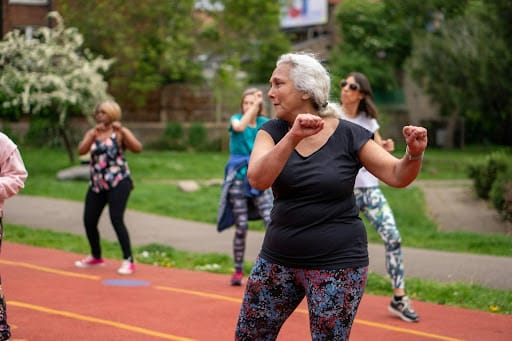A person’s risk of falling increases when they reach their 60s or 70s due to declining mobility. Try these seven exercises to maintain your balance as you get older.
Factors That Increase Fall Risks
Balance problems happen as you age due to functional limitations, but visual issues, depression, taking more than four medications and other health conditions can further increase the chance of falling.
Around one in four Americans aged 65 and older experiences a fall each year. Every 11 seconds, an older adult is treated in the emergency room because of a fall. Exercise is one way to improve balance and and prevent falls.
7 Exercises to Improve Balance
This list of exercises combines strength, flexibility and balance training to increase overall mobility and stability. Health experts suggest a minimum of two strength training days per week. However, before doing anything, ask your doctor if you’re fit to perform any movement.
1. One-Legged Balancing
Researchers say that a good indicator of your overall health is whether you can stand on one leg for at least 10 seconds.
With your feet hip-width apart and your hands on your hips, slowly lift your right leg. Bend it toward your chest, holding the position for a few seconds. Gently release the pose and do the same on the opposite side. Repeat as many times as you want. Use a wall or a chair for support if you’re prone to wobbling.
2. Seated Knee Extensions
These simple knee lifts can increase core strength. Sit in a chair, lengthening your back. Extend your right leg. Engage the muscles on the tops of your thighs and hold the pose for three seconds before lowering it. Switch to your left leg. Repeat this 15 times.
3. Sit-to-Stand Exercise
This routine enhances leg strength and helps you move more comfortably.
Sit on a sturdy chair. Clasp your hands at the back of your head. Stack the neck on top of the spine. Slowly lean forward to a standing position, shifting your weight to the legs for support. Sit back down to your starting pose. Do this 10 times for three sets until you build more power to do an advanced variation.
4. Lunges
Start in a split position, with your right foot in front of the left and about two to three feet apart. Slowly bend both knees until your back leg is a few inches from the ground. Hold for a few seconds. Engage the core and strengthen your feet to return to the starting pose. Repeat as many times as you want.
5. Side-Stepping
This simple routine can increase your ease of movement and response when you’re about to fall. Before exercising, clear the walkways to avoid slips or accidents.
Face sideways with your toes forward. With your back and neck straight and gaze forward, take five giant steps to your right and five to your left. Do this as many times as you’d like.
6. Heel-Toe Walk
This exercise trains your body to stay stable on rough surfaces. If you feel unsteady, do this near your kitchen counter so you have a structure for support.
Stand tall with one hand touching the kitchen counter. Look forward and take 10 slow steps, placing a foot in front of the other to form a straight line. When you reach the end of the path, return to your starting position before turning around and doing it again in the opposite direction.
7. Walking
Walking is the simplest form of movement to enhance your balance. Here are some strategies to maximize the effects of your daily walking routines:
- Stand tall and extend the spine beautifully.
- Gaze forward about 10 to 20 feet in front of you.
- Ensure your shoulders aren’t tense.
- Swing your arms naturally.
- Avoid overarching your back.
- Land your steps from heel to toe to avoid stressing the joints.
Boost Balance With Exercise
Moving has benefits that transcend age. Adding exercise to your daily routine can enhance your stability, help you avoid falls and preserve your independence throughout your golden years.























